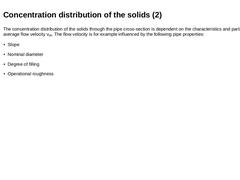
|
The concentration distribution of the solids through the pipe cross-section is dependent on the characteristics and particularly on the average flow velocity vm. The flow velocity is for example influenced by the following pipe properties: -
Slope
-
Nominal diameter
-
Degree of filling
-
Operational roughness
|
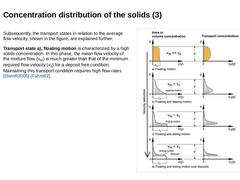
|
Subsequently, the transport states in relation to the average flow velocity, shown in the figure, are explained further: Transport state a), floating motion is characterized by a high solids concentration. In this phase, the mean flow velocity of the mixture flow (vm) is much greater than that of the minimum required flow velocity (vc) for a deposit free condition. Maintaining this transport condition requires high flow rates [SteinR2005] [Führb62]. |
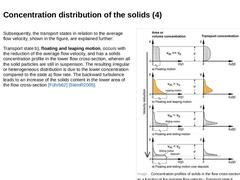
|
Subsequently, the transport states in relation to the average flow velocity, shown in the figure, are explained further: Transport state b), floating and leaping motion, occurs with the reduction of the average flow velocity, and has a solids concentration profile in the lower flow cross-section, wherein all the solid particles are still in suspension. The resulting irregular or heterogeneous distribution is due to the lower concentration compared … |
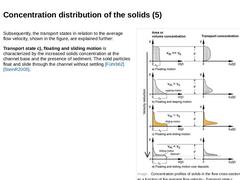
|
Subsequently, the transport states in relation to the average flow velocity, shown in the figure, are explained further: Transport state c), floating and sliding motion is characterized by the increased solids concentration at the channel base and the presence of sediment. The solid particles float and slide through the channel without settling [Führb62] [SteinR2005]. (Image: Concentration profiles of solids in the flow cross-section as a function … |
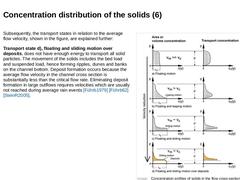
|
Subsequently, the transport states in relation to the average flow velocity, shown in the figure, are explained further: Transport state d), floating and sliding motion over deposits, does not have enough energy to transport all solid particles. The movement of the solids includes the bed load and suspended load, hence forming ripples, dunes and banks on the channel bottom. Deposit formation occurs because the average flow velocity in the channel … |
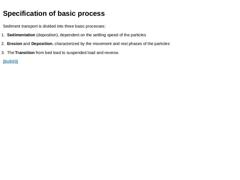
|
Sediment transport is divided into three basic processes: -
Sedimentation (deposition), dependent on the settling speed of the particles
-
Erosion and Deposition, characterized by the movement and rest phases of the particles
-
The Transition from bed load to suspended load and reverse.
[Bollr89] |
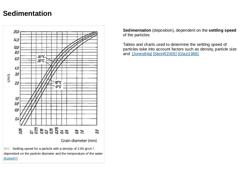
|
(Image: Settling speed for a particle) Sedimentation (deposition), dependent on the settling speed of the particles
Tables and charts used to determine the settling speed of particles take into account factors such as density, particle size and [Jones84a] [SteinR2005] [Glazi1989].
|
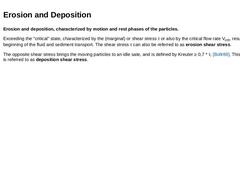
|
Erosion and deposition, characterized by motion and rest phases of the particles. Exceeding the "critical" state, characterized by the (marginal) or shear stress τ or also by the critical flow rate Vcrit, results in the beginning of the fluid and sediment transport. The shear stress τ can also be referred to as erosion shear stress. The opposite shear stress brings the moving particles to an idle sate, and is defined by Kreuter ≥ 0,7 * τ, [Bollr89]. … |
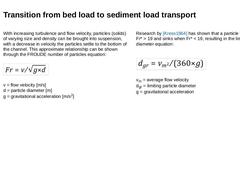
|
With increasing turbulence and flow velocity, particles (solids) of varying size and density can be brought into suspension, with a decrease in velocity the particles settle to the bottom of the channel. This approximate relationship can be shown through the FROUDE number of particles equation:
(Formula: FROUDE-Zahl des Kornes)
v = flow velocity [m/s]
d = particle diameter [m]
g = gravitational acceleration [m/s2]
Research by [Kress1964] has shown … |
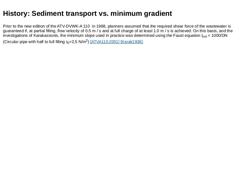
|
Prior to the new edition of the ATV-DVWK-A 110 in 1988, planners assumed that the required shear force of the wastewater is guaranteed if, at partial filling, flow velocity of 0.5 m / s and at full charge of at least 1.0 m / s is achieved. On this basis, and the investigations of Karakassonis, the minimum slope used in practice was determined using the Faust equation Icrit = 1000/DN (Circular pipe with half to full filling τ0=2,5 N/m2) [ATVA110:… |
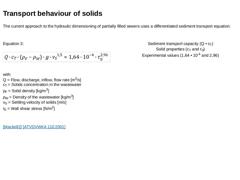
|
The current approach to the hydraulic dimensioning of partially filled sewers uses a differentiated sediment transport equation:
Equation 3: (Formula: hydraulische Dimensionierung von Kanalisationen unter Verwendung einer differenzierten Feststofftransportgleichung in teilgefüllten Rohrleitungen) with:
Q = Flow, discharge, inflow, flow rate [m3/s]
cT = Solids concentration in the wastewater
ρF = Solid density [kg/m3]
ρW = Density of the wastewater [… |
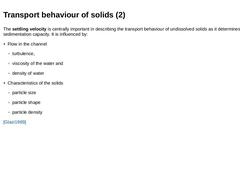
|
The settling velocity is centrally important in describing the transport behaviour of undissolved solids as it determines their sedimentation capacity. It is influenced by: [Glazi1989] |
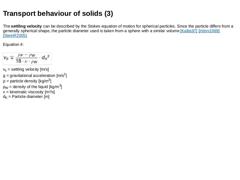
|
The settling velocity can be described by the Stokes equation of motion for spherical particles. Since the particle differs from a generally spherical shape, the particle diameter used is taken from a sphere with a similar volume [Kalbs97] [Hörni1989] [SteinR2005]. Equation 4: (Formula: Stokes Sinkgeschwindigkeit Bewegungsgleichung für kugelförmige Teilchen) vs = settling velocity [m/s] g = gravitational acceleration [m/s2] ρ = particle density [kg/m3… |
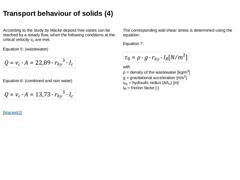
|
According to the study by Macke deposit free states can be reached by a steady flow, when the following conditions at the critical velocity vc are met: Equation 5: (wastewater) (Formula: ablagerungsfreie Zustände bei stationärer Strömung-Schmutzwasser) Equation 6: (combined and rain water) (Formula: ablagerungsfreie Zustände bei stationärer Strömung-Misch- und Regenwasser)
[Macke82]
The corresponding wall shear stress is determined using the equation: |
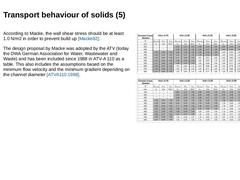
|
According to Macke, the wall shear stress should be at least 1.0 N/m2 in order to prevent build up [Macke82]. The design proposal by Macke was adopted by the ATV (today the DWA German Association for Water, Wastewater and Waste) and has been included since 1988 in ATV-A 110 as a table. This also includes the assumptions based on the minimum flow velocity and the minimum gradient depending on the channel diameter [ATVA110:1988]. |
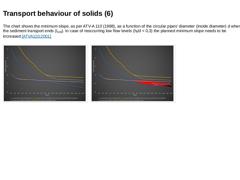
|
The chart shows the minimum slope, as per ATV-A 110 (1988), as a function of the circular pipes' diameter (inside diameter) d where the sediment transport ends (Icrit). In case of reoccurring low flow levels (ht/d < 0,3) the planned minimum slope needs to be increased [ATVA110:2001]. (Image: Minimum slope requirement I crit for a deposit-free operation of circular channels) (Image: Minimum slope requirement I crit for a deposit-free operation of … |
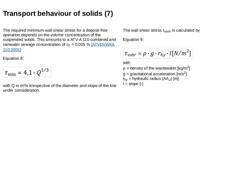
|
The required minimum wall shear stress for a deposit-free operation depends on the volume concentration of the suspended solids. This amounts to a ATV-A 110 combined and rainwater sewage concentration of cT = 0.005 % [ATVDVWKA 110:2001]: Equation 8: (Formula: Volumenkonzentration von der an absetzbaren Feststoffen) with Q in m³/s irrespective of the diameter and slope of the line under consideration.
The wall shear stress τvorh is calculated by Equation … |
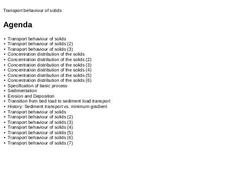
|
|
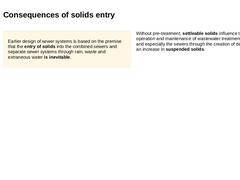
|
Earlier design of sewer systems is based on the premise that the entry of solids into the combined sewers and separate sewer systems through rain, waste and extraneous water is inevitable. Without pre-treatment, settleable solids influence the operation and maintenance of wastewater treatment facilities, and especially the sewers through the creation of deposits and an increase in suspended solids. |
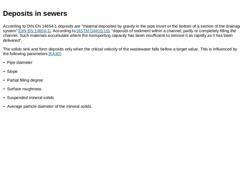
|
According to DIN EN 14654-1 deposits are "material deposited by gravity in the pipe invert or the bottom of a section of the drainage system" [DIN EN 14654-1]. According to [ASTM D4410-16], “deposits of sediment within a channel, partly or completely filling the channel. Such materials accumulate where the transporting capacity has been insufficient to remove it as rapidly as it has been delivered”. The solids sink and form deposits only when the … |
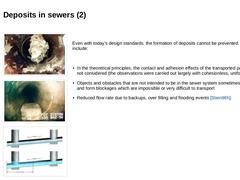
|
(Image: Flow restriction) (Image: General obstacle) (Image: Gravity sewer) Even with today's design standards, the formation of deposits cannot be prevented. The reasons include: -
In the theoretical principles, the contact and adhesion effects of the transported particles were not considered (the observations were carried out largely with cohesionless, uniform material)
-
Objects and obstacles that are not intended to be in the sewer system sometimes …
|
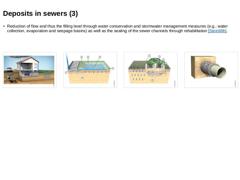
|
-
Reduction of flow and thus the filling level through water conservation and stormwater management measures (e.g., water collection, evaporation and seepage basins) as well as the sealing of the sewer channels through rehabilitation [Stein98h].
(Image: Modified drainage system) (Image: Surface drainage) (Image: Rehabilitation - Liner) |
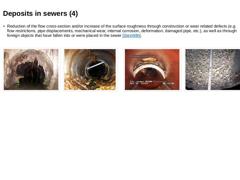
|
-
Reduction of the flow cross-section and/or increase of the surface roughness through construction or wear related defects (e.g. flow restrictions, pipe displacements, mechanical wear, internal corrosion, deformation, damaged pipe, etc.), as well as through foreign objects that have fallen into or were placed in the sewer [Stein98h].
(Image: Flow restriction - Incrustation) (Image: Channel damage - steel rod penetration) (Image: Pipe settlement - severe … |
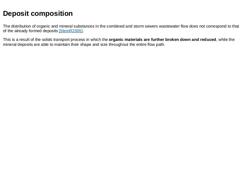
|
The distribution of organic and mineral substances in the combined and storm sewers wastewater flow does not correspond to that of the already formed deposits [SteinR2005]. This is a result of the solids transport process in which the organic materials are further broken down and reduced, while the mineral deposits are able to maintain their shape and size throughout the entire flow path.
|
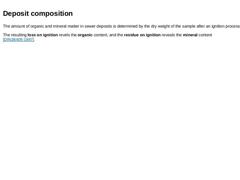
|
(Image: Deposit composition Image 1)The amount of organic and mineral matter in sewer deposits is determined by the dry weight of the sample after an ignition process. The resulting loss on ignition revels the organic content, and the residue on ignition reveals the mineral content [DIN38409:1987]. |